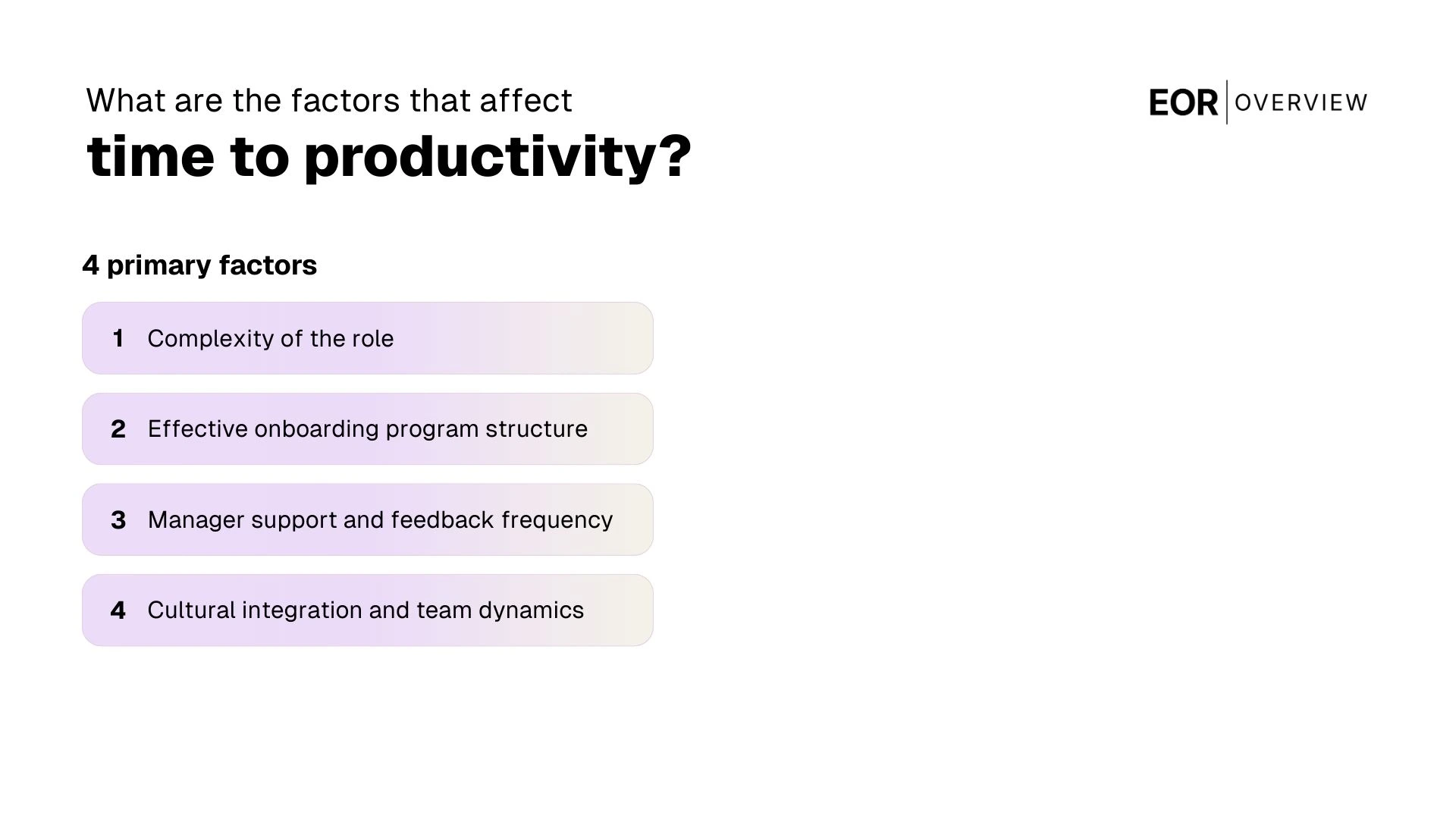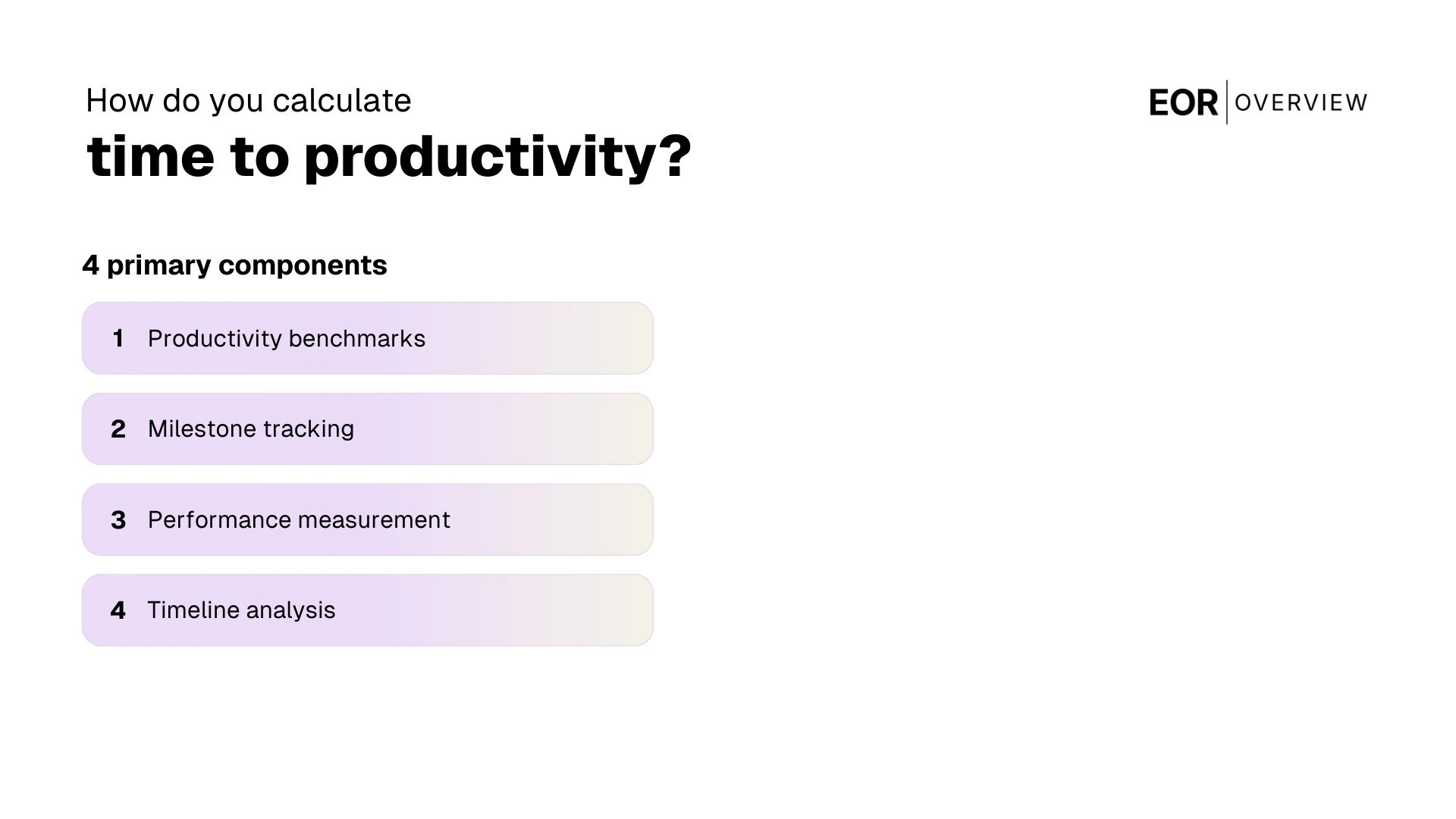Time to productivity is a critical HR metric that measures the duration required for a new employee to reach full performance capacity and contribute meaningfully to their role's objectives.
In today's competitive talent landscape, organizations that can accelerate their time to productivity gain a significant advantage through reduced training costs, improved employee satisfaction, and faster return on hiring investments. This metric has become especially crucial for tech companies, financial institutions, and startups where rapid scaling and immediate impact are essential for business success.
Companies with structured onboarding processes can reduce time to productivity by up to several weeks, directly impacting both bottom-line results and employee retention rates during the critical first-year period.
What is time to productivity?
Time to productivity is a critical metric that measures how long it takes for a new hire to reach their expected performance level and contribute meaningfully to your organization. This measurement captures the entire journey from a new employee's first day through the point where they can independently handle their role responsibilities without constant supervision or support.
The time it takes for employees to reach full productivity varies significantly across industries and roles. In tech companies, software engineers might need 3-6 months to become fully productive, while finance professionals in analytical roles often require 2-4 months. Startups typically see faster acceleration due to their dynamic environments and streamlined processes.
Understanding new hire time to productivity helps organizations optimize their onboarding processes and set realistic expectations. When you measure time to productivity effectively, you can identify bottlenecks in your integration process, allocate resources more efficiently, and demonstrate the ROI of your talent acquisition investments to leadership.
Why is it important to track time to productivity?
Tracking time to productivity provides HR managers with critical insights into how effectively their onboarding and training programs prepare new employees for success. This metric measures the time it takes for a new hire to reach full operational capacity in their role, directly impacting organizational efficiency and budget allocation.
The primary advantages include improved onboarding optimization, cost reduction analysis, performance benchmarking, and strategic workforce planning. These benefits are listed in detail below.
Onboarding optimization: When you calculate and analyze productivity timelines, you can identify bottlenecks in your onboarding process and streamline training modules to help new employees integrate faster.
Cost reduction analysis: Understanding how long it takes for employees to become productive helps you quantify the true cost of hiring and justify investments in better training resources.
Performance benchmarking: Tracking this metric across different roles and departments allows you to establish realistic expectations and identify which positions require additional support structures.
Several factors can significantly affect time to productivity, including role complexity, manager support quality, and the comprehensiveness of your training materials. By monitoring these variables, you can help new hires transition more effectively into their new role while reducing the organizational impact of extended ramp-up periods.

What are the factors that affect time to productivity?
Several key factors determine how long it takes for a new hire to become fully productive in their role. Understanding these variables helps HR managers and hiring managers calculate time to productivity more accurately and develop strategies to reduce time to productivity across their organizations.
The primary factors that influence the time it takes for new employees to reach their date of full productivity include role complexity, onboarding program effectiveness, organizational support systems, and individual employee characteristics. These elements work together to create either a shorter time to productivity or extended ramp-up periods.
Complexity of the role: Technical positions in finance and tech typically require 3-6 months to reach full productivity, while simpler roles may only need 30-90 days to hit key performance milestones.
Effective onboarding program structure: Well-designed employee onboarding processes with clear KPIs and milestone tracking can reduce ramp-up time by up to 50% compared to informal approaches.
Manager support and feedback frequency: Regular check-ins and structured feedback loops help new hires identify gaps quickly and accelerate their path to productivity.
Cultural integration and team dynamics: Strong cultural fit and positive team relationships directly impact retention and performance, with socially integrated employees reaching productivity faster.
Track multiple productivity milestones rather than waiting for 100% productivity. Set 30%, 60%, and 90% benchmarks to identify potential issues early and adjust your onboarding program accordingly.

How do you calculate time to productivity?
Time to productivity refers to the time it takes for a new employee to become fully effective in their position. This metric that measures the duration from an employee's start date until they achieve full productivity provides crucial insights for optimizing your onboarding process.
The calculation requires establishing clear productivity benchmarks, tracking milestones, measuring performance gaps, and analyzing completion timelines. These components are listed in detail below.
Productivity benchmarks: Define what "productive in their role" means for each position by establishing specific performance metrics, output targets, or competency levels that represent full productivity.
Milestone tracking: Monitor key achievements during the onboarding journey, such as completing training programs, passing assessments, or reaching performance thresholds.
Performance measurement: Compare new hire performance against established benchmarks to identify when they reach the desired productivity level.
Timeline analysis: Calculate the average time to productivity across similar roles to identify patterns and optimize your process to help new hires succeed faster.
Extended time to productivity often indicates gaps in training programs or unclear expectations. Regular measurement helps you refine your approach and reduce the time new employees take longer to become effective contributors.
What are the actions to decrease time to productivity?
Time-to-productivity can vary significantly across organizations, but implementing strategic actions helps new hires become productive faster. While some roles may require less time to reach full effectiveness, others demand comprehensive preparation and support systems.
The most effective approaches to accelerate quickly new employee integration include streamlined onboarding processes, targeted skill development, and structured mentorship programs. These strategies directly impact both engagement and retention while reducing the overall investment needed to bring talent up to speed.
Pre-boarding preparation: Send equipment, access credentials, and role-specific materials before the first day to eliminate administrative delays and create immediate momentum.
Structured onboarding and training programs: Develop role-specific curricula that focus on essential skills first, allowing employees to contribute meaningfully within their first few weeks.
Mentorship pairing: Assign experienced team members as guides to provide context, answer questions, and accelerate cultural integration beyond formal training sessions.
Clear milestone tracking: Establish measurable goals for 30, 60, and 90-day periods to monitor progress and identify areas where additional support may be needed.
Create role-specific onboarding checklists that new hires can self-manage. This approach gives them ownership of their progress while ensuring nothing critical gets overlooked during those crucial first weeks.
Why does time to productivity matter for HR teams?
Time to productivity directly impacts your organization's bottom line and competitive advantage in today's fast-paced business environment. When hr teams can effectively reduce the time it takes for new employees to reach full productivity, they create measurable value that extends far beyond the onboarding process.
The ability to improve new employee integration speeds affects every aspect of organizational performance. Faster productivity means quicker project delivery, reduced training costs, and improved team dynamics as new hires contribute meaningfully sooner rather than later.
For hr teams in tech, finance, and startup environments, time to productivity becomes even more critical due to rapid growth cycles and competitive talent markets. When new employees can apply their experience and skills effectively within weeks rather than months, organizations maintain momentum during scaling phases and avoid the productivity gaps that can derail strategic initiatives.
Effective performance management systems that track and optimize time to productivity also provide valuable data for refining hiring processes, identifying skill gaps, and demonstrating hr's strategic impact to leadership through concrete metrics and improved business outcomes.
What are examples of time-to-productivity metrics?
Time-to-productivity metrics help organizations measure how quickly new employees adapt to their new roles and become fully productive. These metrics include time to first task completion, role proficiency achievement, performance target attainment, manager satisfaction ratings, and employee confidence levels.
These examples provide concrete ways to evaluate the effectiveness of their onboarding and training processes across different stages of the new hire journey.
Time to first task completion: Measures how long it takes for a new employee to successfully complete their first meaningful work assignment, typically ranging from 30-90 days depending on role complexity.
Role proficiency timeline: Tracks the days for all new hires to demonstrate core competencies required for their position, helping managers assess when new hires become considered fully productive.
Performance expectations achievement: Evaluates how quickly new employees meet established performance benchmarks, which may take longer for new hires in technical or specialized roles.
Manager satisfaction ratings: Captures supervisor feedback on how well onboarded employees integrate into teams and contribute to business objectives.
Employee confidence surveys: Measures new hire self-assessment of their readiness to perform independently, including their awareness of development opportunities and employee engagement levels.
How long does it take an employee to be fully productive?
The number of days it takes for employees to become fully productive varies significantly depending on the complexity of their role and your organization's onboarding processes. Entry-level positions in tech startups typically require 30-60 days, while senior finance roles may need 90-180 days to reach optimal performance levels in their role.
Several factors determine how long it takes for new hires to develop the necessary skills and integrate into your company culture faster. Access to mentors, comprehensive training programs, and well-documented processes and tools can help employees become productive faster. Organizations that provide structured learning paths and clear performance expectations see their new hire's productivity accelerate significantly.
Failing to track time to productivity metrics can lead to poor resource management and missed opportunities to identify potential areas for improvement in your onboarding process.
To evaluate the effectiveness of your onboarding program, measure specific milestones such as project completions, sales targets achievement, and the employee's ability to work independently. This data helps you allocate resources more efficiently and determine how quickly new hires adapt to their responsibilities, leading to higher retention rates and improved organizational performance.

